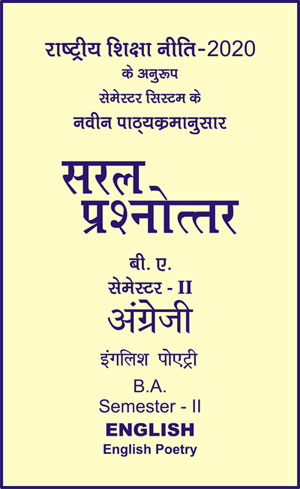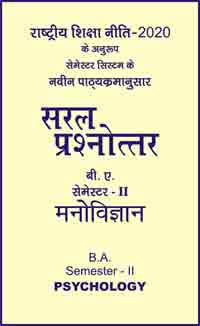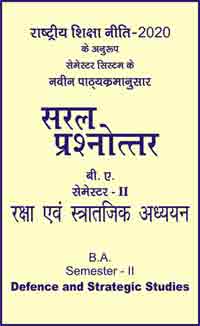|
बी ए - एम ए >> बीए सेमेस्टर-2 - अंग्रेजी - इंगलिश पोएट्री बीए सेमेस्टर-2 - अंग्रेजी - इंगलिश पोएट्रीसरल प्रश्नोत्तर समूह
|
5 पाठक हैं |
|||||||
बीए सेमेस्टर-2 - अंग्रेजी - इंगलिश पोएट्री
Chapter - 1
Forms of Poetry & Stanza Forms
The Sonnet
Sonnet is a kind of subjective poetry. It is a kind of lyric which has an elaborate and fixed structure. It is a poem of 14 lines. So far as its kinds are concerned, there are two kinds of sonnets in vogue: Petrarchan sonnet and English sonnet.
Petrarchan or Italian Sonnet: The sonnet was originally produced in the hands of Petrarch, the Italian poet of fourteenth century. The sonnet is derived from the Italian word 'sonnetto' which means a little sound and strain. Petrarch was the first who used the sonnet of fourteen lines to express his love for Laura, who was his lady love. It turned into an excellent form in the hands of Petrarch. The fourteen lines of this model are divided into an octave of eight lines and sestet of six lines follow the octave. The rhyming scheme of octave never varies. It remains as "abba abba". The thought developed in these first eight lines, which really form one song movement with a definite pause in sense either at one near the end of eight lines. After the pause the sestet catches up the main idea of the octave, gives it a new turn and brings it to an artistic conclusion. This sestet is often divided into two tercets of three lines each with varying rhyme scheme but it never admits a couplet. Petrarch had composed more than three hundred sonnets using different rhyme schemes. Each line consists of eleven syllables. Milton followed very closely the Petrarchan model of sonnets. He made more variations in rhyme scheme of the sestet. For octave, he followed the principles of Petrarchan octave. Wordsworth also followed the Miltonic model but he used a different rhyme ** scheme. Unlike Milton, he did not let an idea run from one part of the sonnet to another. He varied the rhyming both of the octave and the sestet. He used rhyming scheme of "abba, abba, cde, cde".
Shakespearean or English Sonnet: In the beginning, English poets like Wyatt and Surrey had introduced the Italian form in England. But in absence of suitable rhyming words in English, different poets used variety of rhyming arrangements. Spenser was the first who introduced rhyming arrangement of "ab ab, be bc, cd cd, ee". But in general, English poets followed the rhyming scheme of William Shakespeare as "ab ab, cd cd, ef ef, gg". This sonnet consist of three quatrains each of four lines. It has the first and the third and second and fourth rhyme together. With rhyming scheme, English sonnet has become less complex than the Italian. In English sonnets, first twelve lines consists of three quatrains each of four lines and the last two lines make a couplet. The alternate rhyming of each quatrains differs from the alternate rhyming of that of the other two quatrains. Shakespeare had preferred linked quatrains and a couplet at the end and rhyme scheme was "ab ab, be be, cd cd, ee". The second quatrain is connected with the first by the rhyming sound 'b' and the third is connected by the rhyme sound of 'c'. Those is no compulsory rhyme at any point in the first twelve lines. The climax of the main idea is reached in the couplet which is a distinguishing feature of English sonnet.
The Elegy
Elegy is loosely applied to any subjective, reflective poem. It is usually, however, a lament, specifically a lament for the dead. The classic type known as the pastoral elegy, hand its origin among the Sicilian Greeks. In this pastoral type the poet expresses his sorrow in the guise of a shepherd mourning for another fellow-shepherd. This form has been frequently employed by English poets from Spenser down to Matthew Arnold. Good example of this type are Milton's 'Lycidas' and Arnold's Thyrsis'.
In the current literary para language, an Elegy, in its simplest form, is a short lyric of the poet's mourning lament or expression of sorrow over the death of some dear one. It is, therefore, based on absolute sincerity of emotion and expression. Matthew Arnold's 'Rugby Chapel' expressing his personal grief on the death of his father, Dr. Arnold, is a good example of the simple Elegy.
In the present times, the Elegy has become much more elaborate or complex and expanded in many directions. It has often taken the shape of a memorial. Milton's Lycidas' and 'Arnold's Thyrsis' are good memorial elegies. Sometimes, the elegy is used as a medium of expression of the feelings of a whole race, community or humanity. For instance, Gray's Elegy Written in a Country Churchyard', is the poet's lamentation on the death of poor innocent villagers who die unwept, unhonoured and unsung. Shelley's 'Adonais' and Tennyson's 'In Memorium' are excellent examples of this type. Gray wrote 'Ode on the Death of a Favourite Cat' is a Mock-elegy.
In short, we can say that the elegy is a brief lyric of mourning. It may be called the direct utterance of personal bereavement and sorrow. Its basis is absolute sincerity of emotion and expression. In this form of poetry the poet laments on the death of some dear one or the suffering of humanity in general. The best type of elegy, therefore, is that elegy in which the poet turns from personal sorrow to the general sorrow of mankind. The English Elegy differs from the classical that it is written in no special form or metre and restricted in purpose largely to commoration of the dead. The best elegies are characterized by a gentle melancholy rather than a wild passion of grief the poet's motion being 'recollected in tranquility',
The Ode
In ancient Greece, Ode was a poem to be sung by a number of poeple in public or on some important occasions. It expressed the feelings of a whole nation or tribe. Its structure was rigid. It contained three movements-strophe, anti-strophe and the epode. It was mostly set to music. It was accompanied with dancing. The singer moved to one side during the strophe, backwards during the anti-strophe, and stood still during the epode. This was the Pindaric Ode. It was named after its maker Pindar. He was the ancient Greek poet. It is not easy to write a Pindaric Ode. That is why it is not very popular now. Gray's The Bard' and The Progress of Poesy' are good example of this type. Another type of ode is Horation Ode. It is named after Roman poet Horace. Collin's 'Ode to Evening' falls under this category. The third type of the ode is the irregular ode. Later, the poem was imitated by the Roman poet Horace and his ode like Keat's Odes fall under this category.
Kinds of Ode..
There are four different kinds of odes in English literature namely- (i) The Pindaric Ode, (ii) The Horation Ode, (iii) The Regular Ode, (iv) The Irregular Ode.
(i) The Pindaric Ode: The word "Pindaric' has been derived from the name of a great Greek poet known as Pindar. It was Pindar who wrote the kind of song first of all other poets. It is one of the most elaborately composed odes. It is divided into three parts namely the strophe, anti-strophe and the epode which correspond to the three movements of choric dance. Gray is well-known for his Pindaric Odes such as 'The Bard' and 'Progress of Poesy'. The strophe and anti- strophe have mostly twelve lines each and the epode is of seventeen lines or so. The strophe and anti-strophe have the same number of lines and the rhyme scheme, but the epode differs from them both in length and metrical arrangement. This Ode had originated in Greece.
(ii) The Horation Ode: This Ode had been named after the Roman poet, Horace. It is quite simple in its construction. Every stanza of this ode consist of four or more lines. But the number of lines is the same in each and every stanza of the whole Ode. The Horation Ode was the first written and developed in Italy. The Ode 'Upon Cromwell's Return from Ireland' is a fine example of this kind of lyric poem. It is written by Andrew Marwell.
(iii) The Regular Ode: Ode which observe some structural scheme in the arrangement of these stanzas are known as the regular Ode's 'Ode to the Nightingale' and 'Ode to Grecian Urn' of John Keats and 'Ode to Duty' of William Wordsworth belong to this class of Odes. After the death of Thomas Gray the writing of Pindaric Odes came to an end. Then the poets began to write a new kind in which the stanza have a uniform metrical pattern repeated in the course of the whole poem. They are known as regular Odes.
(iv) The Irregular Ode: Those lyric poems which written in stanza of irregular length arrangement, though generally rhymed, are called irregular Odes. The abrupt variations in metre and candence are not arbitrary or meaningless. They have a certain definite artistic purpose to serve. The irregular Odes are characterized by the out word and the visible things of corresponding variations in feeling or in thought also. 'Ode on the Intimation of Immortality' written by Wordsworth is a masterpiece of this type. Again Tennyson's 'Ode on the Death of Duke of Willington' also belong the same category of irregular Ode. :
The Epic.
Epic is a long narrative poem. It deals with heroic figures. It is written in an elevated style. As perfected by the ancient poets, particularly the Greek poet Komey, the epic has a number of distinctive qualities.
(i) The plot of the epic is simple and the events are all related to a central action or theme which gives unity. Thus Homer's Iliad' focuses in the Trojan War and Milton's Paradise Lost' in the fall of man.
(ii) The subject matter is of a sublime nature. The poet usually recounts some traditional story in remote history or mythology, for removed from the trivialities of everyday life.
(iii) The characters are of heroic stature. As in tragedy, one character is usually outstanding and the others are subordinate to him.
(iv) The style is one of sustained grandeur and lofty simplicity, the poet trying to suit his expression to the geat but simple story he feels.
(v) The treatment of the subject is objective.
(vi) The epic is quite different from any other narrative poem. The epic is. based on national mythology and legend, popular beliefs and stories, tradition and thought.
There are four kinds of Epic poetry. The first is called the Epic Proper, the second is known as the Mock-epic, the third is described as the Authentic Epic, or the Epic of Growth and the fourth is termed as the Literary Epic or the Epic of Art. Epic proper includes the last two kinds also. When a trivial theme is clothed in a poetic style and conventional diction, we get Mock-epic. The Authentic Epic is the Epic of Growth for it is made of many talk poems; current stories, legends, ballads and their like. All of them centre round some national hero and other characters are also grand personalities. The writer of this Epic has only to gather all the material shift them and then mould them into an organic whole. The Literary Epic is the Epic of Art. It reveals a conscious purpose of the poet and his writing in the Epic manner. It is a result of the poet's genius, culture and scholarship. It is characterized by mythological heroes and super-natural beings but its style is bookish. It is the product of a conscious literary effort as a scholar poet.
The Ballad
The word Ballad' is derived from the French word 'ballar' means to dance and originally meant a song to which one could dance. It is a narrative in simple rhymed verse. Ballads are songs and words usually of unknown authorship, handed down by word of mouth among the common people and undergoing alterations and additions in the process. Ballads in the medieval times were composed for the delight and instruction of the poeple. The ballads are generally written in the ballad measure. The tale opens abruptly without any attempt at a systematic introduction. Sometimes, it begins with question. and answer. It is impersonal in treatment.
The 15th century was the golden age of the ballad, and the most fertile field was the border country between England and Scotland. Popular ballads are commonly composed in stanzas, often in the four line ballad stanza with alternate iambic petrametre and trimetre lines rhyming ab, cb, some have a refrain; many echo themselves with incrimental repetition. Ballads usually deal with knights and ladies.
Ballad is a term often loosely used of folk song in general. In a stricter sense, it means a traditional narrative composed in stanzas and often including a refrain. The story is told objectively, touching only the peaks of the action; and episodes and details are often given in cumulative repetition. Ballad is a song intended as the accompaniment to dance. Hence, a light simple song of any kind or a popular song often celebrating or attacking persons or institutions. In the modern sense ballad' is a simple spirited poem in short stanzas in which some popular story is graphically narrated.
Like the epic, the ballad arises out of folk literature. It is one of the oldest forms in English. It is one of the few that of native growth. Originally, it was sung from village to village to the accompaniment of a harp or a fiddle, by a strolling singer or bands of singers, who earned a living in this way. The ministrel usually sang in the chimney corner of the farm house or on the village green where a knot of eager listener would assemble to be entertained. Some scholars have also attempted to establish the communal origin of the ballad on the basis of his association with communal dance.
The Lyric
In broader sense all personal poetry is loosely termed lyrical. Originally, lyric poetry was a composition to be sung with a lyre or harp. But in recent time, a lyric is restricted to, mean a short poetic composition in which poet's personal thought and emotions are expressed in a purely personal and musical way. It was the most popular form during the 19th century and formed a great part of that century's poetic work. The spirit of all the romantic poetry of that century was strongly personal and lyrical. Inspired by certain beauties in Nature or life, they drank deep at the fountains of those beauties and poured forth their poetic effusions about them in a flood of lyrical rapture and the result was a powerful lyric throbbing and resounding with the music of their heart.
Thus, the lyric is the expression of the poet's mind in an impassioned moment and is rapid in its movement. It is a rhythmic expression of a strong emotion, as of love, hope, despair, grief, fear or triumph, devotion, patriotism, or friendship etc. It springs up straight from the heart.
The Dramatic Monologue
Dramatic monologue is generally poetic in form. It is addressed to silent and passive andience whose presence is presumed. One who delivers it presumes theat someone hears him. It exhibits his inner struggle. It is a flow of thoughts that passes through the mind of the speaker. It is a type of narrative poetry in which a single character is represented as speaker throughout the poem.
Dramatic monologue is a speech delivered to a silent listener. The speaker always feels that the listener is present throughout and he does not say a word. A dramatic monologue is full of explanations so that the hearer can understand it. It is systematic and orderly.
Robert Browning whether he first created the dramatic monologue or not, is its greatest exponent. Among his best of this type are My Last Duchess', The Laboratory', The Bishop Order His Tomb at Saint', 'Praxed's Church', Fra Lippo Lippi' and 'Andrea Del Sarto'. Tennyson's dramatic monologues are not as good as Browning's, but his 'Ulysses' is a noble and pathetic monologue, if horrible, 'Rizpath' is very moving.
The Allegory
The Allegory is a long story either in prose or in poetry. It has a secondary meaning also. It is a sustained parable. It is satire or mock in hidden or indirect manner. In an allegory, narrator tells an imaginary or historical story but he puts facts about the person or event to whom he wants to satire or criticize. Bunyan's "Pilgrims Progress" is one of the best known allegory. The Faerie Queene' is an elaborate allegory more than one meaning. 'Absalom and Achitophel' is one of finest political allegory of John Dryden. Alexander Pope's 'An Epistle to Dr. Arbuthnot' is one of the best example of personal allegory.
The Heroic Couplet
The term 'Heroic Couplet' is used for a measure consisting of two lines of ten syllables each iambic pentametre rhyming together. The metre is called heroic for it was the typical measure used in epic and poetry to narrate the exploits of heroes. The heroic couplet first presented itself practically full grown in Chaucer. The Legend of Good Women' presents to us Chaucer's first experiement in the heroic couplet, the main pillar later English poetry, and the medium of his greatest work. Chaucer used, this rhymed couplet wonderfully well for the comic portraiture and description, which "The Canterbury Tales" displays.
The next writer in the heroic couplet was Edmund Fairfax, whose version of 'Jerusalem' (1600) is in octaves with distinct final couplets. It was much praised by Waller and his use of the couplet commended itself to Waller Sandys (1517-1643) had also the command of the couplet.
Pope was both a master and innovator in this field. He chose it for literary criticism, for moral preaching, for satire and for burlesque. Dryden developed Drayton's colloquial principle and made the couplet an instrument fittest for discourse. Dryden's handling has a characteristic sweep, and he makes frequent use of Triplets and Alexandrines. Pope's couplets are closed, there is no 'enjambment' in them. The sense is complete, nearly or fully, with each couplet. Each couplet is a separate entity.
The Blank Verse
Blank verse is an unrhymed verse. It is most commonly found in the iambic pentametre in which form it was used, with variations by Shakespeare for the greater part of his plays and by Milton for his 'Paradise Lost'. It was introduced into English by the poet Earl of Surrey in the sixteenth century and was first used for drama by Sevekville and Norton in the tragedy 'Gorboduc.
Blank verse has an elastic form so it is very suitable for a rising and falling emotion or dramatic effect. Variety is created in it by combining run-on with end-stop lines, and inner changing the iambic with other kinds of feet. Shakespeare is the undisputed master of blank verse. It was first attempted by Earl of Surrey in his version of Aenied'. It was practiced with distinction by Marlowe, Shakespeare and Milton.
The Spenserian Stanza
The Spenserian stanza was invented and used by Spenser in his famous epic Faerie Queene'. The Spenserian stanza contains nine lines. Its rhyme scheme is 'ab, ab, bc, bc, c'. It contains eight iambic pentametre and an Alexandrine in iambic hexametre. The stanza is both plain and stately.
The Faerie Queen' of Spenser seems to be influenced by the Italian form of Ottava Rima. Ottava Rima consists of eight lines in iambic pentametre and its rhyme scheme is 'ab ab ab cc'. Some critics think that Ottava Rima was influenced by 'Rhyme Royal' which contains seven lines in iambic pentametre and its rhyme scheme is 'ab, ab, bc, c.
English/7 Some critics are of the opinion that Spenserian stanza is influenced by the Ballad stanza which was used by Chaucer in his 'Monk's Tale' and it is the stanza of eight lines and its rhyme sheme is 'ab, ab, bc, bc'. It appears that Spenser was familiar with Ballad stanza and he simply added a single line to the stanza and formed it with rhyme scheme 'aba, bbc, bec'.
The Terza Rima
The Terza Rima is a three line stanza. A chain rhyme pattern used in Terza Rima. The pattern of chain rhyme is like 'aba, bcb, cdc, ded, efe, and so on'. There is no limit to number of lines in this form, but poems or sections composed repeating the rhyme of the middle of the final tercet. There is no set rhythm for Terza Rima, but in English, iambic pentametre is generally preferred. Actually, it is a verse of three lines, originated from Italian form of Tercets'. It is group of three lines like a Triplet'.
|
|||||
- Chapter - 1 Forms of Poetry & Stanza Forms
- Objective Type Questions
- Answers
- Chapter - 2 Poetic Device
- Objective Type Questions
- Answers
- Chapter - 3 "Let Me Not to the Marriage of True Minds" (Sonnet No. 116)
- Objective Type Questions
- Answers
- Chapter - 4 "On His Blindness"
- Objective Type Questions
- Answers
- Chapter - 5 "Present in Absence"
- Objective Type Questions
- Answers
- Chapter - 6 "Essay on Man”
- Objective Type Questions
- Answers
- Chapter - 7 "Elegy Written in a Country Churchyard”
- Objective Type Questions
- Answers
- Chapter - 8 "The World is Too Much with Us"
- Objective Type Questions
- Answers
- Chapter - 9 "Ode on a Grecian Urn"
- Objective Type Questions
- Answers
- Chapter - 10 "Break, Break, Break"
- Objective Type Questions
- Answers
- Chapter - 11 "How Do I Love Thee?"
- Objective Type Questions
- Answers
- Chapter - 12 "Dover Beach"
- Objective Type Questions
- Answers
- Chapter - 13 "My Last Duchess'
- Objective Type Questions
- Answers
- Chapter - 14 "The Love Song of J. Alfred Prufrock"
- Objective Type Questions
- Answers
- Chapter - 15 "The Lake Isle of Innisfree"
- Objective Type Questions
- Answers
- Chapter - 16 "Church Going"
- Objective Type Questions
- Answers
- Chapter - 17 Rhetoric and Prosody - Practical Criticism
- Objective Type Questions
- Answers














